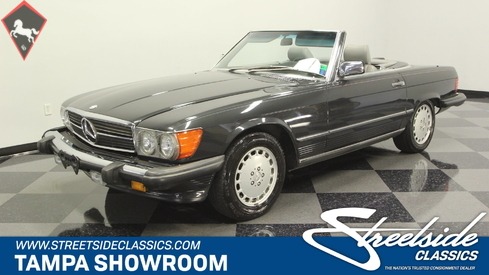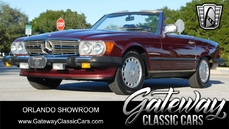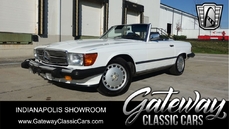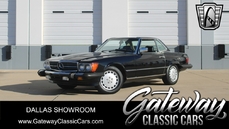Mercedes-Benz 560SL w107 1986
General description :
ONLY 62K ACTUAL MILES, 3 SOUTHERN OWNERS, CLEAN HISTORY, BOTH TOPS, 5.6 V8, NICE
With its beautiful color combo, all the right luxury features, low mileage, and the absolute allure of a droptop Benz, this 1986 Mercedes-Benz 560SL is that ideal mix of sport, comfort, and prestige in an affordable package.
The Black Pearl paint has a great metallic shine that will radiate when the sunlight hits this Mercedes – exactly what you want on a sunshine-friendly droptop. Plus, it's a timeless color that does a terrific job of making the 560SL's classic lines look eternally crisp. In fact, that's one of the reasons why you want this Benz. After all, this car is an icon of its era for being over-built and delivering a more solid feeling than the rest out there. That's why over three decades later the doors close with authority and everything still feels precision-made on this classic. Well that, and you're looking at an example that averaged less than 2,000 miles annually.
A car like this is meant to have a sophisticated presentation with the roof off. So this one gets even the details right with the gray pinstripe on the outside that coordinates with the gray interior. Two deeply-bolstered bucket seats and an armrest center console help you instantly understand what grand touring comfort is all about. There are a ton of features surrounded by glossy wood paneling, including power windows, cruise control, an anti-theft system, driver airbag, and anti-lock brakes. There are also provisions for the factory radio and R134a air conditioning. There's the black folding roof for any time you get caught out in the rain. Plus, a color-matched folding hardtop comes with the sale, too, so you can have a sleek coupe-like profile whenever you want.
Under the hood is the original 5.6-liter V8 motor. It looks like a time capsule on a low mileage vehicle like this, right down to the factory decals. More than just appearance, you want this 560SL because this fuel-injected V8 is a marvel of its time. It has the right power and torque to get you off the line with grace, and it'll keep pulling all the way up to speeds you can only do legally on the autobahn. The four-speed automatic transmission is the ideal pairing as it knows how to snap to attention under acceleration as well as provide terrific overdrive cruising comfort. And with power steering, a fully independent suspension, and four-wheel disc brakes this is one of the few classics that knows how to stay confident on any road.
The sale come complete with the original warranty card, full owner's manual packet, and service manuals. This is a timeless classic that loves the open road, and at a price like this who can resist? Call today!!!
Features : Fuel Injection, Removable Hard Top, Defrost, Anti-Theft System, Service Manuals, Driver Airbag, Cruise Control, Anti-Lock Brakes, Vinyl Interior, Seatbelts, Power Windows, Power Steering, Power Brakes, Four Wheel Disc Brakes, Heat, Air Conditioning, Manual Convertible Top, AM/FM Radio
https://www.streetsideclassics.com/vehicles/1530-tpa/1986-mercedes-benz-560sl
1986 Mercedes-Benz 560SL w107 is listed sold on ClassicDigest in Lutz by Streetside Classics for $18995.
Car Facts
Car type : Car Make : Mercedes-Benz Model : 560SL w107 Engine size : 5.6 Model Year : 1986 Location : Tampa
Sold
Seller Information
Sold
People who viewed this Mercedes-Benz 560SL w107 also viewed similar Mercedes-Benz listed at ClassicDigest
About Mercedes-Benz
In the annals of automotive history, the journey of Mercedes-Benz is a tale that unfolds with the ingenuity of its founding pioneers. In the year 1886, Karl Benz crafted the Benz Patent Motorwagen, a creation that would go down in history as the world's inaugural automobile. Unbeknownst to him, this moment marked the genesis of what would evolve into the most illustrious premium car manufacturer globally. The financial underpinning of this pioneering venture, interestingly, was provided by Karl Benz's wife, Bertha Benz, demonstrating a remarkable partnership that would set the tone for Mercedes-Benz's legacy.A parallel narrative emerged not far away, as Daimler-Motoren-Gesellschaft, founded by Gottlieb Daimler and Wilhelm Maybach, entered the scene. In 1901, they unveiled their automobile under the now-famous moniker "Mercedes," meaning "godsend" in Spanish. This name was bestowed upon the car at the behest of Emil Jellinek's daughter, the distributor for Daimler-Motoren-Gesellschaft. The wheels of innovation were set in motion.
Fast forward to 1926, a pivotal year that witnessed the merger of Daimler with Benz & Cie., culminating in the birth of Daimler-Benz. The amalgamation saw the adoption of "Mercedes-Benz" as the distinguished trademark for their automobiles, fusing the legacies of two visionary entities into one.
Contrary to perceptions of conservatism, the trajectory of Daimler-Benz unfolds as a chronicle of industry firsts. From the introduction of the honeycomb radiator to the float carburetor, and the pioneering implementation of four-wheel brakes in 1924, Daimler-Benz consistently pushed the boundaries of automotive innovation. The diesel-powered Mercedes-Benz 260 D in 1936 marked the inception of diesel engines in passenger cars. The iconic Mercedes-Benz 300SL Gullwing made history as the first car with direct fuel injection, albeit the Gutbrod's tiny 2-stroke engine can claim precedence.
Safety innovations became a hallmark, with Béla Barényi's patented safety cell design in the "Ponton"-models in 1951, featuring front and rear crumple zones. The W116 450SEL 6.9 saw the introduction of the Anti-Lock Brake system (ABS), another pioneering safety feature. From the first production airbags and beyond, the legacy of "firsts" continued to be etched into the fabric of Daimler-Benz.
Over its centennial journey, Mercedes-Benz has not merely produced cars but has sculpted automotive icons. The SSKL, 710 SSK Trossi Roadster, 770K Grosser, 540K Spezial Roadster, 300SL Gullwing, w100 600 Pullman, w111 280SE 3.5 Flachkühler, w113 230SL Pagoda, w109 300 SEL 6.3, and w201 2.3-16 Cosworth stand testament to the brand's commitment to engineering excellence.
The roaring Silver Arrows, or "Silberpfeile," including the W 25, W 125, W154, W165, and W196, created a legacy of dominance on the racetrack. These machines were not merely cars; they were expressions of precision, speed, and an indomitable spirit that left their competitors in the dust.
As Mercedes-Benz marches into the future, it does so not just as an automaker but as a custodian of a legacy, a torchbearer of innovation, and a beacon of automotive excellence. The road ahead is sure to witness the continued fusion of cutting-edge technology, timeless design, and an unwavering commitment to setting new standards in the world of automobiles.
One luminary figure who left an indelible mark was Béla Barényi, often heralded as the "father of passive safety" for his pioneering work in safety engineering. His patented safety cell design, featuring front and rear crumple zones, became a hallmark of Mercedes-Benz's commitment to occupant safety, setting new standards that reverberated throughout the automotive world.
Moving through the chronicles, the collaborative genius of Wilhelm Maybach, alongside Gottlieb Daimler, laid the foundation for Daimler-Motoren-Gesellschaft. Their innovations not only birthed the first Mercedes but established a culture of relentless pursuit of technological excellence that remains integral to Mercedes-Benz's DNA.
In the post-merger era of 1926, Ferdinand Porsche emerged as a prominent figure within Mercedes-Benz. His work on the Mercedes-Benz S-Type, a supercharged race car, garnered acclaim and set the stage for a legacy that extended far beyond the marque. Porsche's impact would later extend to his eponymous company, but his influence at Mercedes-Benz during those formative years was pivotal.
As the 20th century progressed, the legendary Rudolf Uhlenhaut emerged as a key figure. Uhlenhaut, an accomplished engineer and the driving force behind the iconic Silver Arrows, played a crucial role in Mercedes-Benz's dominance in motorsports. His engineering prowess and attention to detail were instrumental in creating some of the most formidable racing cars of the era.
In the latter half of the century, figures like Bruno Sacco, the head of design at Mercedes-Benz from 1975 to 1999, left an indelible imprint on the brand's aesthetic identity. Sacco's design philosophy, characterized by clean lines and timeless elegance, shaped iconic models like the W126 S-Class and the W201 190E, solidifying Mercedes-Benz's reputation for luxury and sophistication.
The narrative would be incomplete without acknowledging the contributions of engineers like Hans Scherenberg, whose leadership in the 1970s ushered in a new era of technological innovation at Mercedes-Benz. Scherenberg's tenure saw the development of groundbreaking technologies, including the Anti-Lock Brake system (ABS) and the introduction of airbags in production cars.








